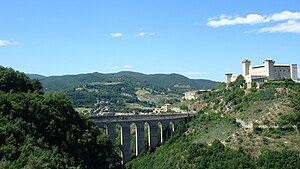Ponte delle Torri
Coordinates: 42 ° 43 ′ 59 " N , 12 ° 44 ′ 37" E
| Ponte delle Torri | ||
|---|---|---|
| Ponte delle Torri and Rocca Albornoziana fortress | ||
| use | aqueduct | |
| Convicted | Tessino | |
| place | Spoleto (Italy) | |
| overall length | 230 m | |
| height | 76 m | |
| completion | 14th Century | |
| location | ||
|
|
||
| Above sea level | 400 m | |
The Ponte delle Torri ('Bridge of the Towers') is a medieval aqueduct near Spoleto in the south of the central Italian region of Umbria . With its height of about 76 meters - the information varies depending on the source - it towers over all ancient and also most modern aqueducts by far.
location
The Ponte delle Torri crosses the valley of the Tessino river ; it is less than a kilometer southeast of the historic center of the city of Spoleto. Its northeast flank is dominated by the medieval fortress Rocca Albornoziana on the Sant'Elia hill.
history
In the past, the aqueduct was associated with the Ostrogothic king Theodoric the Great († 526), who liked to stay in Spoleto and was also a builder here. More likely, however, is a later creation: The French-born Pope Innocent VI, who resides in Avignon . († 1362) was - after the reconquest of the central Italian possessions of the Papal States by Cardinal Gil Álvarez Carrillo de Albornoz in 1354 - around the middle of the 14th century fortress Rocca Albornoziana built to in this way the territorial claims of the papacy in central Italy to document. It is possible that the aqueduct was built at this time; others advocate starting construction as early as the 13th century (possibly on Roman or late Roman foundations) - details cannot be said. The aqueduct was in operation until the 19th century and ensured the supply of Spoleto.
architecture
The approximately 230 m long and maximum 76 m high structure is composed of several solid-looking pillars with different distances that were or are only connected to each other at three points by slight arches or semi-arches. The pier cores made of quarry stone masonry are clad on the outside with better-hewn limestone ; and bricks are very much to see - but it could have been supplemented in subsequent repairs. The two central pillars have staircases inside, which would be unthinkable with a Roman aqueduct. The aqueduct also differs from most ancient Roman constructions by the building materials and the dominance of the vertical, so that - also in view of the historical circumstances - a medieval construction project can be assumed. Perhaps right from the start, perhaps only later, the aqueduct bridge arched in the middle; this was compensated for by a precisely leveled wall, no more than twelve meters high, on which the actual water pipe ran. The wall is flush with the substructure on one side; there is a pedestrian path on the other side. In the middle of the path there was a small room for the guard, who also collected the bridge toll here .
Others
Johann Wolfgang von Goethe already admired the aqueduct on his Italian trip in 1786.
See also
literature
- Lamberto Gentili et al .: L'Umbria. Manuali per il Territorio. Edindustria, Rome 1977–1980.
Web links
- Ponte delle Torri - Photo + Info (English)






